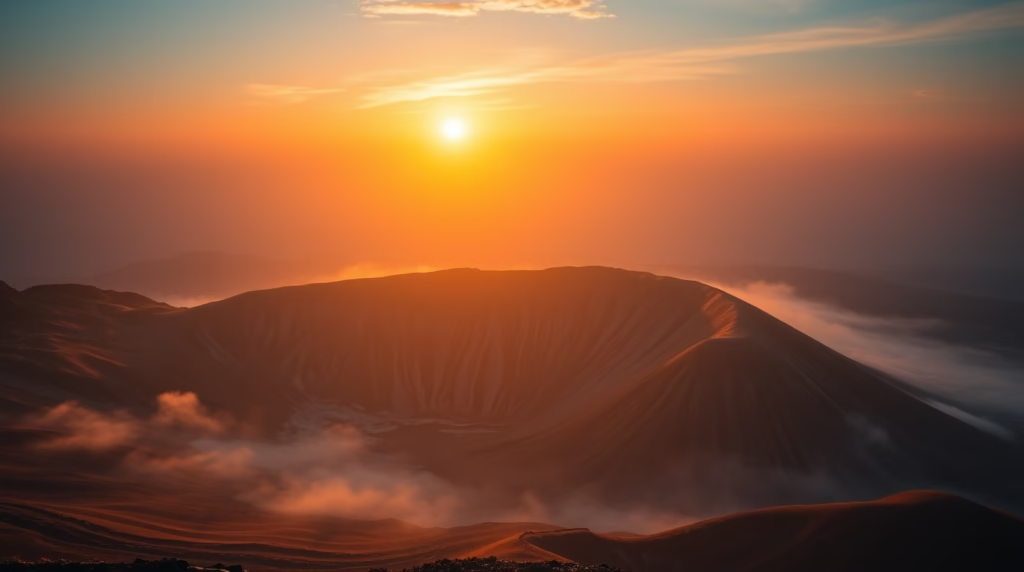Unraveling the Enigma of Savonoski Crater: Alaska’s Perfectly Round Mystery
Deep within the rugged expanse of Alaska’s Katmai National Park lies a geological anomaly that has captivated and confounded scientists for decades: the Savonoski Crater. This strikingly circular depression, a near-perfect geometric form etched into the Alaskan wilderness, presents a puzzle that has defied easy explanation, sparking debates and fueling scientific curiosity.
A Visual Marvel: The Savonoski Crater’s Defining Features
From an aerial perspective, the Savonoski Crater commands attention. Its near-perfectly round shape, approximately 1,600 feet (500 meters) in diameter and plunging to a depth of 360 feet (110 meters), evokes a sense of profound mystery. As documented in a 1978 publication by the University of Alaska Fairbanks, the crater’s basin is partially filled with water, a tranquil pool fed by the region’s abundant rainfall and snowmelt. This serene, water-filled expanse further accentuates the crater’s distinct, almost otherworldly appearance.
The Meteorite Hypothesis: A Compelling, Yet Unproven, Theory
The crater’s circularity naturally leads to comparisons with meteorite impact craters, which are typically characterized by their round, bowl-shaped forms. The sheer visual resemblance has prompted many to speculate that Savonoski might be the result of a cosmic collision. However, despite its compelling appearance, conclusive evidence supporting this hypothesis remains elusive.
Extensive geological surveys conducted in the 1960s and 1970s failed to uncover the telltale signs of a meteorite impact. These investigations found no traces of meteoritic material, nor did they identify shocked quartz or other rock formations indicative of the intense pressures and temperatures associated with a high-velocity impact. Furthermore, the absence of ejecta—rock fragments scattered around the crater rim by the force of an impact—further weakens the meteorite theory.

The Volcanic Maar Alternative: An Explosive Possibility
As an alternative to the impact theory, scientists have considered the possibility that Savonoski Crater is a volcanic maar. Maars are broad, low-relief volcanic craters formed by explosive eruptions when rising magma encounters groundwater. The resulting interaction generates superheated steam, which can lead to powerful explosions that excavate large, circular depressions.
The Ukinrek Maars in Alaska, particularly the eastern maar formed during a 1977 eruption, offer a compelling example of this phenomenon. These volcanic craters, like Savonoski, are often filled with water, further reinforcing the similarity. However, the absence of any known volcanic landforms in the immediate vicinity of Savonoski Crater, coupled with the lack of evidence for a magma source beneath the depression, casts doubt on this explanation.
The Glacial Veil: Obscuring the Crater’s True Origins
The Savonoski Crater’s history is further complicated by the fact that it has undergone at least one glaciation event since its formation. During the last glacial maximum, between 23,000 and 14,700 years ago, the region was blanketed by a vast ice sheet. This glacial activity likely played a significant role in eroding and obscuring the crater’s original features, potentially erasing crucial clues about its formation.
As noted by the University of Alaska Fairbanks, the glacial ice would have effectively swept away any surface evidence of the crater’s origins, leaving scientists to grapple with a heavily modified landscape. This glacial scouring could explain the absence of ejecta or other surface features typically associated with impact or volcanic craters.
The Quest for Answers: Future Research and Potential Discoveries
Despite the challenges, scientists remain committed to unraveling the mystery of Savonoski Crater. The consensus among researchers is that the crater is likely either a meteorite impact structure or a volcanic maar. However, definitive answers will require further, more extensive investigations.
One promising avenue for future research involves drilling into the crater’s center. By retrieving core samples from the subsurface, scientists could potentially identify hidden evidence of the crater’s formation. This could include traces of meteoritic material, shocked minerals, or volcanic deposits that have been preserved beneath the glacial till and water fill.
The Enduring Fascination: Savonoski Crater’s Place in Scientific Exploration
The Savonoski Crater stands as a testament to the enduring power of scientific curiosity. Its perfectly round form, shrouded in mystery, continues to inspire awe and wonder. As scientists delve deeper into its secrets, they are not only seeking to understand the crater’s origins but also to gain insights into the dynamic geological processes that have shaped the Alaskan landscape.
The Savonoski Crater, with its unanswered questions, serves as a reminder that even in the age of advanced technology, the natural world still holds many surprises. It is a symbol of the ongoing quest for knowledge and the relentless pursuit of scientific understanding, a testament to the fact that mysteries, when approached with rigor and dedication, can ultimately yield profound discoveries. The future exploration of Savonoski Crater promises to be an exciting chapter in the ongoing story of Earth science.
more NEWS || click